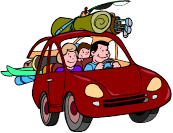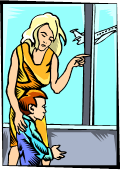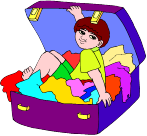TRAVELING WITH School vacation and summer are especially busy times for family travel. The geographic mobility of our nation has expanded travel for you and your children. Although even neighborhood visits require some preparation, long automobile trips and airline travel are very common for families. By age five, children are allowed to travel as unaccompanied minors on airlines, and some fly quite happily to visit a parent or grandparents. Preparation at all levels makes travel a happier experience for children, their parents, and other travelers who share the same mode of transportation. AUTOMOBILE TRAVEL The automobile continues to be the most common means of travel for families. For preschoolers up to the age of four there should be no other choice but sitting in a safety approved car seat. After age four, seat belts are a must, but the front seat is no longer an alternative for children traveling in cars that have front seat air bags. Children do get restless in the confinement of a car seat. Whether trips are short or long, the timing of your trip seems to contribute to the comfort of the trip for everyone. If the trip is only a short one to visit a friend, family member, or neighbor, rested children probably travel best, only because they're not cranky. Furthermore, if young children are not rested, they tend to fall asleep in a moving car, and fifteen minutes is hardly enough for a nap, so they are likely to be only partially rested when you reach your destination. You can keep your children busy for short rides by observing trucks or shops along the way, listening to children's onger car rides require the opposite approach. Hopefully, you can tire your children out before your trip by giving them extra running around time or planning much of the trip for when they usually nap or sleep. Potty breaks will be necessary approximately every two to three hours during the day. Use the breaks for some active running around if possible. Surprises tucked away in separate bags can be opened every few hours on a long trip. The bags can contain toys that can be played with in the car as well as some surprise healthy snacks. Try to avoid snacks containing too much sugar since the extra energy sugar provides will only make it harder for your children to sit still. The easiest time to travel long distances with children is at night when they're asleep. A good novel on tape can keep the driver concentrating, but it does take willing night drivers and some pre-arranged child care at your destination to recover from the long night drive. Children aren't always entirely rested when you arrive, but the trip is easier on the adults doing the driving.AIR TRAVEL Flying is a very popular form of travel for family members of all ages, and air travel is usually viewed as fun for children. It is certainly easy to make a plane ride a fun excursion. Prior to your flight, encourage your children to do some running around For toddlers whom you may carry or push in strollers, they'll be desperate for some movement before the plane ride (or you will be desperate during the flight). Airports often have play-rooms or pods with play equipment that are excel-lent for the climbing and sliding that little ones need before the long periods of sitting begin. Many flights no longer offer food, and even when they do, it may be food your children would not usually choose to eat. Airplane flights are not a good time for food arguments. If you haven't brought a snack or sandwich with you, you may wish to purchase something in the airport to bring ab A trip to the restroom before the flight is a high priority. The airplane lavatory may be off limits just when your children are in absolute need. Most airlines permit preboarding with children, and while that means extra time to be seated on the airplane, it permits you to settle in before other passengers board. It also permits you to pick up a pillow and blanket, which may encourage your children's napping. Be sure to store your children's travel bag under the seat in front of you rather than in the rack above your head. You may just need something it contains to maintain your children's peace and contentment during the flight. There's lots to show your children outside the plane window before you take off. Equipment and machinery for preparing the plane and storing the luggage provides new vocabulary and entertainment for a preschooler. If you don't know the terminology, a visit to the library or bookstore before your trip can provide you with books that can help your children become airport experts. Even the airline attendants may be impressed, and if the flight isn't too crowded, your children may be able to meet the friendly pilot and even receive
INDEPENDENT AIR TRAVEL Not every five-year-old should be traveling alone, but if your children are very seasoned travelers and if there's a loving and dependable family member at the end of an airplane trip to greet your independent traveler, traveling alone is certainly a confidence builder for children unequaled by almost any other experience. However, independent flights are not a good idea to push on a child who doesn't feel ready or who is fearful. If the child really feels ready for a trip, and the trip doesn't involve changing airplanes, you can feel confident that the airlines will handle your child carefully and safely.
Summary Advice:
For tips on preschool or independent travel consult Dr. Rimm's book, "Raising Preschoolers: Parenting for Today" (New Work: Three Rivers Press, 1997) Click to order |
©2008-2012 by Sylvia B. Rimm. All rights reserved.
Report any problems with this site to Webmaster@sylviarimm.com

 music on cassette tapes, singing children's songs, or just chatting about the visit.
music on cassette tapes, singing children's songs, or just chatting about the visit. oard. Eating also keeps your children busy, so it's a good idea for them to eat during the flight.
oard. Eating also keeps your children busy, so it's a good idea for them to eat during the flight.  For your children's first airplane trip, you'll want them to know what to expect when they take off, and if they're not sleeping by then, they'll need preparation for understanding the noises and feelings of the plane's take-off and landing. If you, too, are a new traveler, ask the flight attendant. Knowing what to expect relieves the feelings of anxiety you might have if you're not sure what's normal. If your children seem anxious, reading to them, playing a game, or listening to children's music on a portable cassette recorder dissipates fears for children rather easily. If your toddler is still drinking a bottle or using a pacifier, the sucking seems to alleviate pressure in their little ears during take off and landing; likewise, if your breastfeeding and don't mind the lack of privacy, the nursing will make your baby more comfortable. If your children are beyond all that and know how to chew gum, it, too, helps relieve ear pressures. Some airline attendants will supply ear covers that seem to help small children if they're uncomfortable. Cupping your hands over their ears also helps some children. Some small children don't seem to be bothered at all by the flight, so you may even wonder at these suggested precautions.
For your children's first airplane trip, you'll want them to know what to expect when they take off, and if they're not sleeping by then, they'll need preparation for understanding the noises and feelings of the plane's take-off and landing. If you, too, are a new traveler, ask the flight attendant. Knowing what to expect relieves the feelings of anxiety you might have if you're not sure what's normal. If your children seem anxious, reading to them, playing a game, or listening to children's music on a portable cassette recorder dissipates fears for children rather easily. If your toddler is still drinking a bottle or using a pacifier, the sucking seems to alleviate pressure in their little ears during take off and landing; likewise, if your breastfeeding and don't mind the lack of privacy, the nursing will make your baby more comfortable. If your children are beyond all that and know how to chew gum, it, too, helps relieve ear pressures. Some airline attendants will supply ear covers that seem to help small children if they're uncomfortable. Cupping your hands over their ears also helps some children. Some small children don't seem to be bothered at all by the flight, so you may even wonder at these suggested precautions.  Be sure to arrive at the gate early. You'll have special paperwork to complete to assure communication and appropriate pick up. Furthermore, your child will be escorted on the plane by the attendant before others are seated. Usually you are not permitted on the plane for departure. Prepare yourself for remaining calm. The idea of your child traveling alone may be more traumatic for you than it is for your child. Definitely send along favorite books or toys for the trip if only to reassure yourself. A special surprise within the travel bag to be opened after take off will also help. A telephone call to the greeting family member after the plane is no longer in view will confirm that a loving recipient will be at the other end of the flight to hug and greet and to absolutely prove by picture identification that they are the legally correct party to accept the child. An immediate call from the person meeting the plane is important reassurance that your little traveler has arrived. After the pioneer flight, you and your child will feel much more comfortable about them traveling alone, and they can visit their parent or grandparents more frequently.
Be sure to arrive at the gate early. You'll have special paperwork to complete to assure communication and appropriate pick up. Furthermore, your child will be escorted on the plane by the attendant before others are seated. Usually you are not permitted on the plane for departure. Prepare yourself for remaining calm. The idea of your child traveling alone may be more traumatic for you than it is for your child. Definitely send along favorite books or toys for the trip if only to reassure yourself. A special surprise within the travel bag to be opened after take off will also help. A telephone call to the greeting family member after the plane is no longer in view will confirm that a loving recipient will be at the other end of the flight to hug and greet and to absolutely prove by picture identification that they are the legally correct party to accept the child. An immediate call from the person meeting the plane is important reassurance that your little traveler has arrived. After the pioneer flight, you and your child will feel much more comfortable about them traveling alone, and they can visit their parent or grandparents more frequently.